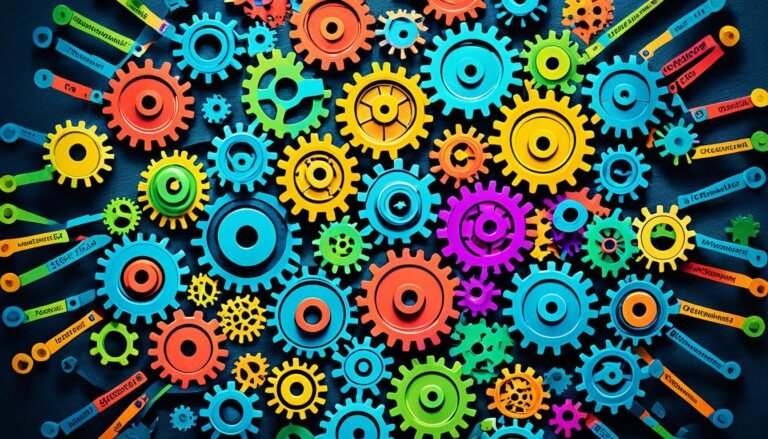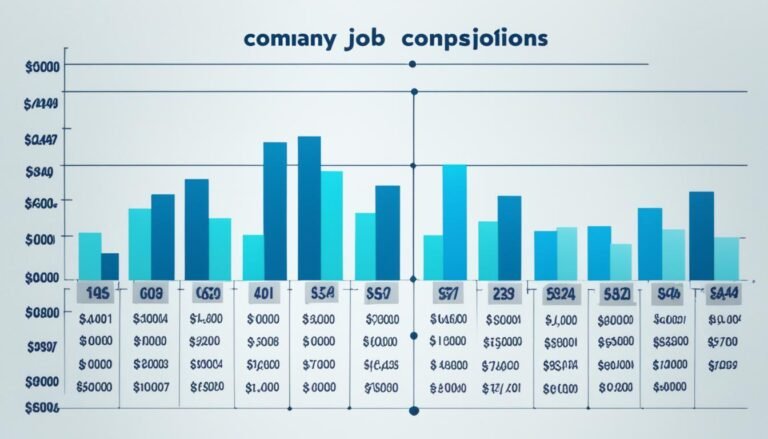A guide to HR Management Systems
An HR system, also known as a human resources management system (HRMS) or human resources information system (HRIS), is a powerful tool that allows organizations to efficiently store employee information and streamline core HR processes. By leveraging HR software, companies can enhance their HR capabilities, improve employee engagement, and make data-driven decisions.
Key Takeaways:
- HR Management Systems, also referred to as HRIS or HRMS, facilitate the storage of employee information and streamline core HR processes.
- HR software enables organizations to enhance HR capabilities, improve employee engagement, and make data-driven decisions.
- Implementing an HR system offers benefits such as increased efficiency, self-service features, integrated tools, data compliance, and sustainable scaling.
- There are different types of HR systems, including HRIS, HCM System, and HCM, each serving specific purposes.
- Choosing the right HR system requires careful evaluation of features, cost, and organizational needs.
What is an HR System?
An HR system is a comprehensive tool that enables the storage of employee information and facilitates various HR processes. It serves as a centralized database for critical HR data, allowing organizations to efficiently manage the entire employee lifecycle, from recruitment to offboarding.
By implementing an HR system, organizations can streamline workforce planning, succession planning, and people strategy initiatives. This powerful tool empowers HR teams and employees alike by unlocking the benefit of time, enabling them to focus on high-impact projects and strategic activities that drive business growth.
The Benefits of an HR System:
- Efficient Storage of Employee Information: HR systems provide a secure and organized platform for storing and retrieving employee data, eliminating the need for manual paperwork and reducing the risk of data loss.
- Automated HR Processes: An HR system automates various HR processes, such as employee onboarding, performance management, and leave management, increasing operational efficiency and reducing administrative burden.
- Improved Compliance: HR systems help organizations stay compliant with labor laws and regulations by providing features like automated time tracking, leave management, and payroll integration.
- Enhanced Decision-Making: HR systems provide real-time access to key HR metrics and analytics, enabling data-driven decision-making and strategic workforce planning.
- Increased Employee Engagement: With self-service capabilities and easy access to information, HR systems empower employees to manage their own HR-related tasks, fostering a sense of ownership and engagement.
- Integration with Other Systems: Modern HR systems seamlessly integrate with other business systems, such as payroll and performance management, ensuring data consistency and eliminating manual data entry.
- Scalability: HR systems are designed to accommodate the growing needs of organizations, allowing for seamless scaling as the workforce expands.
Implementing an HR system is a crucial step toward creating an efficient and effective HR function within an organization. Whether it’s a small startup or a large enterprise, an HR system eliminates manual processes, enhances data accuracy, and empowers HR teams to focus on strategic initiatives that drive business success.
Are There Different Types of HR Systems?
HR systems play a crucial role in managing human resources, but not all systems are created equal. Different types of HR systems cater to specific organizational needs and provide varying levels of functionality. Let’s explore the three main types:
1. HRIS (Human Resource Information System)
An HRIS, or Human Resource Information System, is designed to streamline core HR processes and keep track of employee data. It provides a centralized platform for storing employee information, managing payroll, tracking attendance, and handling benefits administration. HRIS systems are ideal for organizations seeking an all-in-one solution to efficiently manage employee data and automate routine administrative tasks.
2. HCM System (Human Capital Management System)
A Human Capital Management (HCM) System goes beyond traditional HRIS functionalities by placing a greater emphasis on talent management and strategic workforce planning. HCM systems offer features such as performance management, succession planning, talent acquisition, and learning management. These systems are well-suited for organizations looking to align their workforce strategy with business objectives and foster employee development.
3. HCM (Human Capital Management)
HCM refers to the broader concept of managing an organization’s most valuable asset – its people. While an HCM System encompasses the functionalities of an HRIS and an HCM system, it also focuses on creating a people-centric work environment. An HCM system takes a holistic approach to workforce management, supporting employee engagement, culture development, and employee experience throughout the entire employee lifecycle. It emphasizes data-driven decision-making to optimize HR processes and foster organizational growth.
One example of a top-performing HR software that falls into the third category, offering additional functionality to enhance people-focused work, is Personio.
| HR System Type | Main Features |
|---|---|
| HRIS (Human Resource Information System) | – Employee data management |
| HCM System (Human Capital Management System) | – Talent acquisition |
| – Performance management | |
| HCM (Human Capital Management) | – Employee engagement |
| – Culture development | |
| – Data-driven decision-making |
The 7 Benefits of HR Systems
Implementing an HR system can provide several benefits for organizations. These benefits include:
- Gaining back time through efficiency: HR systems streamline administrative tasks, allowing HR teams to allocate more time to strategic initiatives and value-added activities.
- Enabling self-service and engagement for employees: HR systems empower employees to access and manage their own information, such as updating personal details, viewing payslips, and requesting time off, promoting employee self-sufficiency and engagement.
- Integrating tools and tasks: HR systems consolidate various HR tools and tasks into a single platform, creating a centralized hub where HR professionals can efficiently manage processes, such as recruitment, performance management, and training.
- Ensuring data compliance: HR systems help organizations maintain data compliance by securely storing and managing employee information, ensuring adherence to privacy regulations.
- Enabling data-driven decisions: HR systems provide robust analytics and reporting capabilities, enabling HR professionals to gain valuable insights from employee data and make data-driven decisions to support organizational growth and success.
- Facilitating sustainable scaling: HR systems are scalable, accommodating the growth and changing needs of organizations. They provide the flexibility needed to support rapid expansion while maintaining efficient HR processes.
- Never losing an approval: HR systems automate approval workflows, preventing approvals from falling through the cracks and ensuring timely decision-making.
Implementing an HR system can transform HR functions, improving efficiency, empowering employees, and providing valuable insights for strategic decision-making.
| Benefit | Description |
|---|---|
| Gaining back time through efficiency | HR systems streamline administrative tasks, freeing up time for strategic initiatives. |
| Enabling self-service and engagement for employees | HR systems empower employees to access and manage their own information. |
| Integrating tools and tasks | HR systems consolidate various HR tools and tasks into a single platform. |
| Ensuring data compliance | HR systems securely store and manage employee information to ensure regulatory compliance. |
| Enabling data-driven decisions | HR systems provide analytics and reporting capabilities to support data-driven decision-making. |
| Facilitating sustainable scaling | HR systems are scalable, accommodating organizational growth and changing needs. |
| Never losing an approval | HR systems automate approval workflows to ensure timely decision-making. |
What Do HR Systems Look Like in Practice?
HR systems can vary significantly in their implementation and appearance, depending on the organization. While some companies may still rely on outdated methods such as spreadsheets, emails, and cumbersome manual processes to manage their HR tasks, others have embraced modern solutions like all-in-one HR software systems. These software solutions provide a centralized platform for HR management, combining multiple HR functions and streamlining processes for increased efficiency.
For small and medium-sized enterprises (SMEs) and their HR teams, the HR system may not resemble a traditional system at all; instead, it often consists of a collection of scattered documents and employee data. This fragmented approach can make it challenging to access and manage critical HR information, resulting in inefficiencies and potential data discrepancies.
Benefits of Implementing a Robust HR System
- Streamlined processes: An HR system automates tedious and time-consuming tasks, reducing manual effort and improving overall efficiency. It enables HR teams to focus on strategic initiatives and high-impact projects.
- Centralized data: With an HR software solution, all employee data is stored in one secure location, ensuring data integrity and easy access. This minimizes the risk of data loss or inconsistency caused by scattered documents and spreadsheets.
- Enhanced reporting and analytics: HR systems provide advanced reporting and analytics capabilities, allowing HR professionals to gain insights and make data-driven decisions. These insights can drive improvements in recruitment, performance management, and employee engagement.
- Improved compliance: An HR system helps organizations stay compliant with labor laws and regulations by automated record-keeping and timely reminders for important tasks such as performance reviews or contract renewals.
Implementing a comprehensive HR system can transform HR processes, leading to increased productivity, improved employee experiences, and better organizational outcomes. It is essential to choose an HR software solution that aligns with an organization’s specific needs and offers the necessary features for effective HR management.
Do Startups Often Need an HR System?
Startups are known for their innovative and fast-paced nature. As they grow, so do their HR needs. While it may seem like startups can function without an HR system during their initial stages, implementing an HR system becomes crucial as they establish a strong HR foundation. An HR system provides startups with the necessary tools and processes to effectively manage their workforce and drive growth.
One of the key benefits of an HR system for startups is the ability to maintain a consistent onboarding experience. As startups hire new employees, it’s important to ensure a smooth and streamlined onboarding process. An HR system automates onboarding tasks, such as document collection and employee information input, allowing startups to focus on creating a positive employee experience right from the start.
Furthermore, an HR system helps startups scale their leadership bench. As startups grow rapidly, they need to identify and develop the right talent to assume leadership positions. An HR system provides tools for talent management and succession planning, enabling startups to identify high-potential employees and provide them with growth opportunities.
“Implementing an HR system right from the start helps startups build a strong HR foundation and ensures that they have the right tools and processes in place to support their growth.”
In addition, an HR system plays a vital role in ensuring a high degree of quality and culture alignment within the startup. Startups often have a unique culture and values that they want to preserve as they expand. An HR system helps in maintaining this culture by enabling startups to track employee performance, provide continuous feedback, and align individual goals with organizational objectives.
Overall, startups can greatly benefit from implementing an HR system. It allows them to streamline HR processes, maintain a consistent onboarding experience, scale their leadership bench, and ensure quality and culture alignment. With the right HR software, startups can focus on their core business while effectively managing their most important asset—their people.
| Benefits of an HR System for Startups: |
|---|
| 1. Streamline HR processes |
| 2. Maintain a consistent onboarding experience |
| 3. Scale leadership bench |
| 4. Ensure quality and culture alignment |
Common HR Processes for an HR System
An HR system provides comprehensive support for various HR processes, streamlining workflows and enhancing efficiency. Here are some common HR processes that can be effectively managed and automated using an HR system:
- Applicant Sourcing and Tracking: An HR system simplifies the process of sourcing and tracking job applicants, allowing HR teams to manage candidate information, track their progress, and streamline the recruitment process.
- Onboarding: With an HR system, organizations can automate the onboarding process, ensuring a smooth transition for new employees. Tasks such as employee documentation, access provisioning, and training can be efficiently managed.
- Data Management: An HR system serves as a centralized repository for employee data, allowing HR teams to store, update, and access information with ease. This eliminates the need for manual record-keeping and ensures data accuracy and security.
- Attendance Tracking: HR systems offer attendance tracking features, enabling organizations to monitor employee attendance, manage leave requests, and generate reports for payroll processing.
- Absence Management: With an HR system, organizations can efficiently manage employee absences, including leaves, vacations, and other time-off requests. This helps ensure proper workforce planning and minimize disruptions.
- Performance and Training: An HR system facilitates performance management processes, including goal setting, performance evaluations, and development planning. It also enables the management of training programs and tracking employee progress.
- HR Reporting: HR systems generate comprehensive reports on various HR metrics, providing valuable insights for decision-making and strategic planning. These reports can include employee demographics, turnover rates, training effectiveness, and more.
By implementing an HR system, organizations can automate these HR processes, reduce manual tasks, enhance data accuracy, and improve overall productivity. This allows HR teams to focus on strategic initiatives and better support the needs of the workforce.
Which Processes Should an HR System Tackle First?
When implementing an HR system, it is crucial to prioritize foundational processes that lay the groundwork for effective HR work. By addressing these essential processes first, organizations can optimize their HR management and streamline their operations.
Here are the key processes that an HR system should tackle first:
- Employee Self-Service: Empowering employees with self-service capabilities allows them to access, update, and manage their personal information, reducing administrative burdens for HR teams and promoting efficiency.
- Applicant Tracking: Streamlining the applicant tracking process ensures a smooth and structured approach to recruitment, enabling HR teams to efficiently manage job openings, review applications, and track candidate progress.
- Absence Management: Implementing an effective absence management system helps track employee leave, manage leave requests, and ensure compliance with company policies.
- Digital Employee Files: Transitioning from paper-based employee records to digital files centralizes and secures employee data, making it easily accessible for HR personnel and streamlining documentation processes.
Incorporating these processes into an HR system allows organizations to build a strong foundation for their HR management, improve data accuracy, enhance operational efficiency, and provide better employee experiences.
By automating these essential HR processes, organizations can reap the benefits of a streamlined and efficient HR system, enabling HR teams to focus on strategic initiatives, employee development, and driving organizational success.
Should an HR System Offer Automation?
The right HR systems understand the value of automation as a critical feature. Automation not only streamlines routine administrative tasks but also reduces manual labor, enabling HR teams to focus on strategic initiatives. By automating repetitive processes, such as data entry and report generation, HR software enables efficiency and accuracy in HR operations.
Automation in HR systems goes beyond simply saving time and effort. It also allows for seamless integration with other organizational tools, such as performance management software, payroll systems, and collaboration platforms. This integration enhances data flow and ensures consistent and accurate information across various systems, enabling better decision-making and productivity.
One emerging trend in HR automation is People Workflow Automation. This approach empowers HR teams and businesses to create customizable workflows, automate approvals, and track the progress of HR processes. With People Workflow Automation, organizations can streamline tasks like leave requests, expense reimbursements, and performance appraisals, reducing administrative burden and improving employee experiences.
Automation in HR systems not only saves time but also enhances accuracy, data integrity, and overall HR effectiveness.
By leveraging automation in HR systems, organizations can achieve several key benefits:
- Increased efficiency and productivity: Automation eliminates time-consuming manual tasks, enabling HR teams to focus on strategic responsibilities.
- Improved data accuracy and compliance: Automation minimizes human errors and ensures data integrity, enabling organizations to maintain compliance with regulations.
- Enhanced employee experience: By automating self-service functionalities, employees can easily access and update their information, reducing administrative hurdles and fostering engagement.
- Better decision-making: Automation enables real-time access to accurate HR data, facilitating data-driven decision-making and strategic workforce planning.
- Streamlined approval processes: Automated workflows reduce bottlenecks in HR processes, ensuring timely approvals and improving overall operational efficiency.
Implementing an HR system with robust automation capabilities is essential for modern HR management. It empowers HR teams to shift their focus from administrative tasks to strategic initiatives, leading to increased efficiency, improved employee experiences, and better organizational outcomes.
What Do HR Systems Typically Cost?
The cost of implementing an HR system can vary depending on multiple factors, including the size of the company, the desired plan and features, and the need for any additional add-ons. It is essential to consider these factors carefully when selecting an HR system to ensure that it aligns with the organization’s requirements and budget.
A leading HR software provider, Personio, offers three comprehensive plans tailored to the needs of modern businesses. These plans are:
- The Essential Plan: Designed for small businesses looking for essential HR functionality.
- The Professional Plan: Suited for growing companies that require advanced HR tools and features.
- The Enterprise Plan: Ideal for larger organizations with complex HR needs and a high number of employees.
By offering these different plans, Personio allows businesses of all sizes to find a suitable option that caters to their specific needs. Whether you are a startup, small business, or enterprise-level organization, Personio provides a scalable and cost-effective HR software solution.
Implementing an HR system can provide significant benefits and streamline HR processes, saving time and improving overall efficiency. When considering the cost, it is important to evaluate not only the initial investment but also the long-term value and return on investment that a robust HR system can deliver.
Conclusion
Implementing an HR management system is essential for optimizing workforce efficiency and streamlining human resources processes. These systems, such as HR software and HR solutions, offer a wide range of benefits that can revolutionize HR operations and drive organizational success.
One of the key advantages of HR management systems is the significant time savings they provide. By automating manual administrative tasks and enabling self-service capabilities for employees, HR teams can focus on strategic initiatives and high-impact projects.
Moreover, HR systems empower organizations with integrated tools and data-driven insights. From HR analytics to compliance with data privacy regulations, these solutions ensure accurate and actionable information that supports effective decision-making and enables sustainable scaling.
When selecting an HR system, it is crucial to carefully evaluate features, cost, and organizational needs. By choosing a robust and comprehensive HR management system, businesses can effectively manage their HR processes, enhance employee experiences, and unlock the full potential of their workforce.







